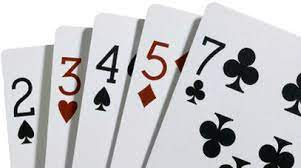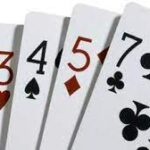For the past few weeks, we’ve been looking at the basis of pre-draw hand distributions. In this week’s edition, we’re going to put it all together and start looking at actual pre-flop hand ranges as a whole. You will need to know the material from the first three parts of this series if you want to really understand what we’re doing here. We’re going to summarize this material and move on to putting together entire pre-draw ranges. Let’s get started.
The Magic Numbers for Pat Hands: 1-4-10-20-35-76
This series of six numbers, the sums of the triangular numbers, give us a ton of information about the number of ways to have hands. For pat hands, we base the number of ways off of the kickers starting with 5 (since that’s the lowest kicker we can have) and going up. For example, a pat hand that’s X-5 will have 1 way that it can be dealt, a pat hand that’s X-6 will have 4 ways to be dealt, a pat hand that’s X-7 will have 10 ways to be dealt, and so on. You just have to remember to subtract 1 in the case of something like 7-6, 8-7 or 9-8 because there’s one way to be dealt a straight, and we don’t want that in our total.
Example 1: How many ways can you be dealt a pat 9?
This includes the pat 9-5(1 way), 9-6(4 ways), 9-7(10 ways) and 9-8(20 ways). We have to subtract 1 from the 9-8 ways because of the straight, so there are 34 ways to be dealt a pat 9. Since there are 1,024 hand combinations of each of these ways, there are 34,816 different hand combinations. You can see why we track this game’s starting hands with ways to be dealt a hand instead of hand combinations because the numbers are overwhelming.
The Magic Numbers for Draw Hands: 1-4-10-20-35-76
For draws, we use the same set of numbers with a multiplier that we call the drawing factor. The drawing factor is 3 + the number of high cards you would discard for this particular draw. The draws start at 5xxx with 1 base way, 6xxx for 4 base ways, 7xxx for 10 base ways, and so on. (Note: The xxx in these draws are three cards that are lower than the lead card.) You multiply the number of base ways for each draw by the drawing factor to get the total number of ways that you can be dealt a specific drawing hand.
Example 2: How many ways can you be dealt an 8xxx draw if you’re discarding an ace, king, queen and jack?
The base ways for an 8xxx draw is 20. The drawing factor is 3 + 4 high cards, so we multiply 20 by 7 to get 140 ways to be dealt this draw. If we multiply this by 1,024, we’ll have the total number of hand combinations for this draw: 143,360. You’re welcome.
Evaluating a Pre-Draw Range
There are 2,598,960 starting hand combinations in five card draw games like 2-7 single draw. That’s a pretty big number, but we can use it to figure out the percentage chance of having different hands.
Example 3: If we open raise with pat hands ten or better and draws to a 9xxx or better where we are discarding an ace, king, queen or jack, then what percentage of hands are we open raising?
Note that if we’re raising with a pat ten or better, then we have to be discarding jacks. If we weren’t discarding jacks, then that would mean that we would be playing pat jacks as well.
Let’s list out the pat hands and the number of ways to have each: 7-5(1), 7-6(4), 8-5(1), 8-6(4), 8-7(10), 9-5(1), 9-6(4), 9-7(10), 9-8(20), T-5(1), T-6(4), T-7(10), T-8(20), T-9(35). Remember that we have to subtract 1 each from the totals for the 7-6, 8-7, 9-8 and T-9 to account for straights. That comes to a total of 4 for the pat 7s, 14 for the pat 8s, 34 for the pat 9s and 69 for the pat Ts. Note we can use these totals in the future as a shortcut.
Now we need to figure out the ways to have the draws. For the 5xxx it’s 1 base way, for 6xxx it’s 4 base ways, for 7xxx is 10 base ways, 8xxx is 20 base ways, and 9xxx is 35 base ways. That’s a total of 70. The drawing factor is 3+4, so we multiply 70 by 7 to get a total of 490 ways to get these draws.
At this point, we’ll have a ratio of 121:490 of pat hands to drawing hands. That’s a total of 611 ways to have these hands which is 625,664 total starting hand combinations. If we divide that by 2,598,960, then we’ll find that this is about 24.07 percent of all starting hands.
Moving Past Pre-Draw Ranges
If you want, you can make a quick spreadsheet of these values that will make it easy to figure out what percentages of hands you’re working with. You can also incorporate pat hand bluffs into the mix at appropriate levels, but that’s not something we’re going to get in-depth about just yet since that’s going to be more of a post-draw discussion. Just note that the hand combinations for paired hands is a little different, so something like 22777, which is an excellent bluffing hand, will not have 1,024 starting hand combinations.
Note: We compensated for this with one-card draws with our drawing factor starting point of 3. See part 3 of the series for an in-depth discussion on why that works.
Next week, we’re going to start to look at post-flop distributions with draws, what types of hands you can expect to get on average when you make a draw, and how this relates to what your range will look like after the draw.
Learn More
No-Limit 2-7 Single Draw Strategy (Part 1): The Basics
No-Limit 2-7 Single Draw Strategy (Part 2): Pat Hand Combinations
No-Limit 2-7 Single Draw Strategy (Part 3): Draw Combos
No Limit 2-7 Single Draw Strategy (Part 4): Pre-Draw Overview
No-Limit 2-7 Single Draw Strategy (Part 5): Post-Draw With Draws
Submit your review | |






